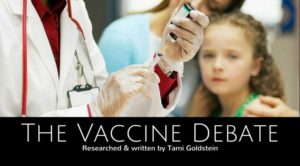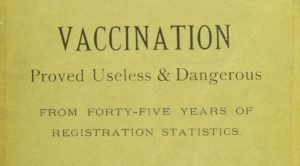All links on this page provide information on outbreaks of infectious disease in highly vaccinated populations:
- Measles outbreak in a fully immunized secondary-school population
An outbreak of measles occurred among adolescents in Corpus Christi, Texas, in the spring of 1985, even though vaccination requirements for school attendance had been thoroughly enforced. Serum samples from 1806 students at two secondary schools were obtained eight days after the onset of the first case. Only 4.1 percent of these students (74 of 1806) lacked detectable antibody to measles according to enzyme-linked immunosorbent assay, and more than 99 percent had records of vaccination with live measles vaccine.
Source: New England Journal of Medicine - Outbreak of Measles Among Persons With Prior Evidence of Immunity, New York City, 2011
Measles was eliminated in the United States through high vaccination coverage and a public health system able to rapidly respond to measles. Measles may occur among vaccinated individuals, but secondary transmission from such individuals has not been documented.
Source: Bureau of Immunization, New York City Department of Health and Mental Hygiene; National Center for Immunization and Respiratory Diseases, Centers for Disease Control and Prevention; Westchester County Department of Health, New York - Vaccines and Pregnancy: The Criminal Conspiracy to Create Autism
The CDC has been given an annual budget of over $11 billion dollars to spend, which is provided under the auspices of protecting the American public from various health care threats, but are they really doing that? There’s plenty of incriminating data available to prove that they’re doing just the opposite of that.
Source: Kinsei Mind Body - Zika Virus Infection, Cambodia, 2010
Zika virus (ZIKV), a member of the family Flaviviridae, genus Flavivirus, was first isolated from the blood of a sentinel rhesus monkey from the Zika Forest of Uganda in 1948. Since that time, serologic studies and virus isolations have demonstrated that the virus has a wide geographic distribution, including eastern and western Africa; the Indian subcontinent; Southeast Asia; and most recently, Micronesia. The virus is transmitted primarily through the bite of infected mosquitoes and most likely is maintained in a zoonotic cycle involving nonhuman primates, although recent evidence suggests the possibility of occasional sexual transmission in humans. Few case reports have described the clinical characteristics of ZIKV infection in humans. Most reports describe a self-limiting febrile illness that could easily be mistaken for another arboviral infection, such as dengue or chikungunya fever. We report a confirmed case of ZIKV infection in Cambodia.
Source: Centers For Disease Control and Prevention - Germany battling measles outbreak 10 times worse than the one in U.S. (Feb. 2015)
While authorities there had hoped to completely eliminate the disease this year, 254 new cases emerged in January, primarily in Berlin. Considering that Germany has a quarter the population of the United States, the January measles surge there was 10 times worse than the U.S. outbreak.
Source: Washington Post - Assessing the risk of measles resurgence in a highly vaccinated population: Belgium Anno 2013
Based on a multicohort model approach, using spatial serological survey data, MMR vaccination coverage data and data on social contacts, we found effective reproduction numbers significantly higher than 1 for measles in Belgium. This indicates that at one of the expected re-introductions, a measles outbreak is likely to spread, especially when it occurs during school term.
Source: EuroSurveillance Edition 2015: Vol. 20 Issue 1 Article 4 - A Cross-Sectional Study of a First Measles and Rubella Vaccination and a Second Measles, Mumps, and Rubella Vaccination
The reported coverage of the measles–rubella (MR) or measles–mumps–rubella (MMR) vaccine is greater than 99.0% in Zhejiang province. However, the incidence of measles, mumps, and rubella remains high. In this study, we assessed MMR seropositivity and disease distribution by age on the basis of the current vaccination program, wherein the first dose of MR is administered at 8 months and the second dose of MMR is administered at 18–24 months.
Source: PLoS One, Vol. 9(2); 2014 - Waning of Maternal Antibodies Against Measles, Mumps, Rubella, and Varicella in Communities With Contrasting Vaccination Coverage
The combined measles, mumps, and rubella (MMR) vaccine has been successfully administered for >20 years. Because of this, protection by maternal antibodies in infants born to vaccinated mothers might be negatively affected.
Source: Oxford Journals - The Journal of Infectious Disease - Souderton Area High School in 'outbreak' status due to whooping cough cases (March 2015)
There were five cases of possible whooping cough, also known as pertussis, recently under investigation at Souderton Area High School, according to Montgomery County Communications Director Frank Custer. Three of the five individuals were confirmed to have the disease by the Montgomery County Health Department, which classified this as an “outbreak.” The health department determines cases based on the Centers for Disease Control and Prevention definition, he said. The other two students did not meet that criteria, but were clinically recognized as having the condition by the healthcare providers who evaluated and treated them, he explained via email Tuesday morning.
Source: Mainline Media News - 19 kids in Summit Co. diagnosed with whooping cough despite being up to date on vaccinations (March 2015)
A whooping cough outbreak is causing concern in Summit County as 19 children have been diagnosed, and it’s the first time in years Park City schools have seen a case of pertussis. Officials said all of the children who have been diagnosed were vaccinated against the illness.
Source: FOX 13 - Salt Lake City - Utah Whooping Cough Outbreak (Pertussis) Only in Vaccinated Children (April 2015)
An alarming outbreak of pertussis (whooping cough) is currently sweeping through the Park City, Utah area. And the news is not good for the vaccine industry – as you’ll soon see. This whooping cough outbreak marks the first time in many years that the area has experienced even one case of pertussis. So far, 19 kids have been diagnosed with the illness.
Source: Global Research News - Unexpectedly Limited Durability of Immunity Following Acellular Pertussis Vaccination in Pre-Adolescents in a North American Outbreak
This first detailed analysis of a recent North American pertussis outbreak found widespread disease among fully vaccinated older children. Starting approximately three years after prior vaccine dose, attack rates markedly increased, suggesting inadequate protection or durability from the acellular vaccine.
Source: Oxford Journals - Clinical Infectious Disease - Reemergence of pertussis in the highly vaccinated population of the Netherlands: Observations on surveillance data
This study analyzed pertussis reporting, death, hospitalization, and serodiagnostic data from 1976 to 1998 to help explain the cause of the 1996 pertussis outbreak in the Netherlands. The unexpected outbreak was detected by an increase in pertussis reporting and by other surveillance methods.
Source: Department of Infectious Disease Epidemiology, National Institute of Public Health and the Environment, Bilthoven, the Netherlands - Largest Measles Epidemic in North America in a Decade—Quebec, Canada, 2011: Contribution of Susceptibility, Serendipity, and Superspreading Events
The largest measles epidemic in North America in the last decade, occurred in 2011 in Quebec, Canada, where rates of 1- and 2-dose vaccine coverage among children 3 years of age were 95%–97% and 90%, respectively, with 3%–5% unvaccinated.
Source: Oxford Journals - The Journal of Infectious Disease


